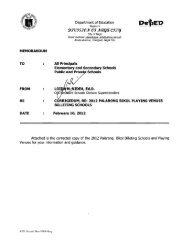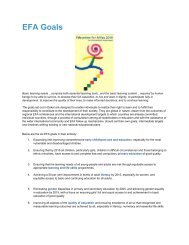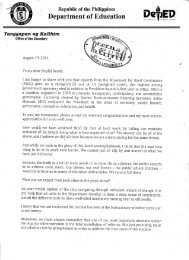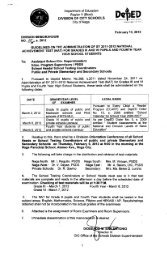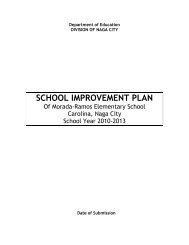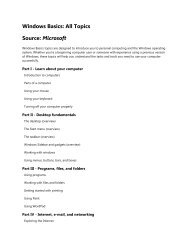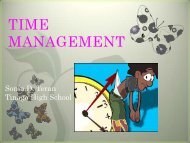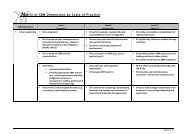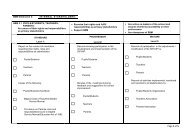science teacher's guide - DepEd Naga City
science teacher's guide - DepEd Naga City
science teacher's guide - DepEd Naga City
Create successful ePaper yourself
Turn your PDF publications into a flip-book with our unique Google optimized e-Paper software.
Teacher's GuideModule 3: Elements & CompoundsActivity2The Periodic Table: It’s Element-ary!In Activity 1, they were able to generate two elements — hydrogen andoxygen. In this activity, they will find out that these two elements are just afraction of the numerous elements currently existing. Also, that these arethe substances that are homogeneous which are made up of only onecomponent. Being so, they are said to be the “simplest form of matter”.All of the elements are systematically organized in the periodic table. Itwas described to be “amazingly” done as varied information about all of theelements are laid out in a single table. Patterns and trends are evident in thearrangement. It serves as a handy reference and as such was labelled as achemist’s tool. This tool can then be a good starting material to learn aboutthe different elements. However, note that this is the first time for thestudents to formally use this tool. Being so, this activity, as it walks themthrough the periodic table, focuses only with the basic information — nameand symbol. Do not overwhelm them with the vast information the periodictable can provide. Worse, if they are required to memorize its contents.Gradually, let them realize these different information through variedactivities that require its use. In that manner, they may find the periodictable not that complicated — it’s even quite simple that it’s “element-ary”.Reminders• Periodic table is a tool in Chemistry that we can refer to every nowand then. The more we use it, the more we get to be familiar withwhat it contains. Thus, there is no need to memorize such table.• A periodic table is provided at the end page of Modules 3 and 5. Theinformation placed there is limited to the scope of the module forthis quarter. It is highly encouraged to begin with the names andsymbols of the elements as they try to know what the elements are.Group number will be introduced at the latter part of the activity.Atomic numbers, at this point, will serve as a <strong>guide</strong> on howelements are sequenced in the table; it will not be defined as thenumber of protons of an element’s atom. The latter will be discussedin grade 8 when they have already learned about the particulatenature of matter.Grade 7 Science: MatterDiversity of Materials in the Environment 34




